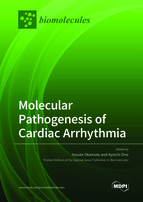Molecular Pathogenesis of Cardiac Arrhythmia
A special issue of Biomolecules (ISSN 2218-273X). This special issue belongs to the section "Molecular Biology".
Deadline for manuscript submissions: closed (31 March 2022) | Viewed by 29720
Special Issue Editors
Interests: heart rhythm; cardiac arrhythmia; atrial fibrillation; ventricular arrhythmia; ion channel; heart transcriptome; adrenergic signaling pathway
Special Issues, Collections and Topics in MDPI journals
Interests: cardiac automaticity; analysis of cell and organ functions on the basis of electrophysilogical methods; cardiovascular physiology; ion channel; transporter
Special Issue Information
Dear Colleagues,
As is well known, sustainable heart contractions with a regular rhythm are essential for life. Thus, the processes underlying the heartbeat have long been a significant focus of science. To our knowledge, the human heart is the first functional organ that starts to beat at embryonic week four. Once the heart’s function is activated, the heart continues to pump out oxygenated blood and fuel for the rest of one’s life. Several transcription factors have been reported to engage in the development of the early heart. In adults, ion channels, Ca2+ handling, muscle fibers, and cell signaling networks are regarded as fundamental to cardiac physiology. Several recent studies have shown that epigenetic regulation and immunologic responses also impact heart functions. Generally, cooperation among tens of thousands of biomolecules plays a role in maintaining cardiovascular homeostasis, and disorders of the principal system can lead to severe illnesses. Arrhythmia, disturbances of cardiac beating, can be life-threatening or, occasionally, lethal. Ventricular arrhythmias cause sudden cardiac death, while supraventricular arrhythmias, such as atrial fibrillation, complicate cerebral embolism, heart failure, and dementia. Unsurprisingly, there has recently been increasing interest in translational studies on the pathophysiology of cardiac arrhythmia.
This Special Issue, “Molecular Pathogenesis of Cardiac Arrhythmia”, will address novel insights into arrhythmia’s molecular mechanism based on original work. Our interests cover molecular biology, biochemistry, regenerative medicine, electrophysiology, mathematical simulation, bioinformatics, epigenetics, proteomics, and immunology.
Dr. Yosuke Okamoto
Dr. Kyoichi Ono
Guest Editors
Manuscript Submission Information
Manuscripts should be submitted online at www.mdpi.com by registering and logging in to this website. Once you are registered, click here to go to the submission form. Manuscripts can be submitted until the deadline. All submissions that pass pre-check are peer-reviewed. Accepted papers will be published continuously in the journal (as soon as accepted) and will be listed together on the special issue website. Research articles, review articles as well as short communications are invited. For planned papers, a title and short abstract (about 100 words) can be sent to the Editorial Office for announcement on this website.
Submitted manuscripts should not have been published previously, nor be under consideration for publication elsewhere (except conference proceedings papers). All manuscripts are thoroughly refereed through a single-blind peer-review process. A guide for authors and other relevant information for submission of manuscripts is available on the Instructions for Authors page. Biomolecules is an international peer-reviewed open access monthly journal published by MDPI.
Please visit the Instructions for Authors page before submitting a manuscript. The Article Processing Charge (APC) for publication in this open access journal is 2700 CHF (Swiss Francs). Submitted papers should be well formatted and use good English. Authors may use MDPI's English editing service prior to publication or during author revisions.
Keywords
- atrial fibrillation
- heart rhythm
- sudden cardiac death
- ventricular arrhythmia







